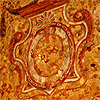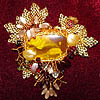- sale
- new items
- lovely beads
- wedding beads
- beads for teens
- for custom order
- newsletter
- recognition
- testimonials
- birthstones
- zodiac signs
- jewelry guide
SHOP BAG
![]() in your bag 0 items
in your bag 0 items
November gem is amber; you can read about that sunny gem in our newsletter. The bulk of amber in the world is found in the Baltic region mostly in Russia, and much less in Poland. Amber has been found washed up on the coasts of England, Norway, and Denmark. A lesser known sources of amber are on the Mediterranean and on the Adriatic, in Netherlands, Denmark, Dominican Republic, Mexico, in the United States and in Indonesia.
Many myths surround the origin of amber. Ovid in Metamorphoses wrote about Phaethon, who convinced his father Helios, the Sun God, to allow him to drive the chariot of the sun across the sky for a day. He drove too close to the earth, setting it on fire. To save the earth, Zeus struck Phaethon out of the sky with his thunderbolts, plunging him into the sea. His sisters, the Heliades, the daughters of Helios, the Sun, turned into poplar trees on the bank of the Eridanus River:
And each tear as it falls shines in the water, a glistening drop of amber.
To the Norse, amber was the golden tears of the Goddess Freya that fell into the sea and solidified. Polish legends ascribe amber to human tears from the forty-day rain. A Kashubian legend says amber was created from very loud lightning storms. To the ancient Greeks, amber came from the apples of immortality (hence the name, "amber" from the Greek ambrotos, meaning ambrosia). From this legend, amber was believed to instill protection to its wearer and increase longevity. The Romans picked up on this, believing amber a first rate protector, so much so, the Roman Gladiators adorned their shields and weapons with it. In Christianity, Amber is thought to be tears shed by birds at Christ's death.
A Lithuanian amber myth tells about the story of lost love. Perkunas, God of Thunder, was the father God and his daughter was Jurate, a mermaid who lived in an amber palace in the Baltic. One day a fisherman named Kastytis would cast his nets to catch fish from Jurate's kingdom. The goddess sent her mermaids to warn him to stop fishing in her domain. He did not stop, so Jurate went herself to demand he stop. Once she saw him she fell in love and brought him back to her amber palace.
Perkunas, knowing Jurate was promised to Patrimpas, God of Water, was angered to find his daughter in love with a mortal. Perkunas destroyed the amber palace with a bolt of lightening to kill her mortal lover. Her palace was destroyed and Jurate was chained to the ruins for eternity. When storms in the Baltic stir the sea, fragments from the amber palace wash up on shore. Pieces in the shape of tears are particularly treasured, as they are the tears from the grieving goddess, as she weeps tears of amber for her tragic love.




